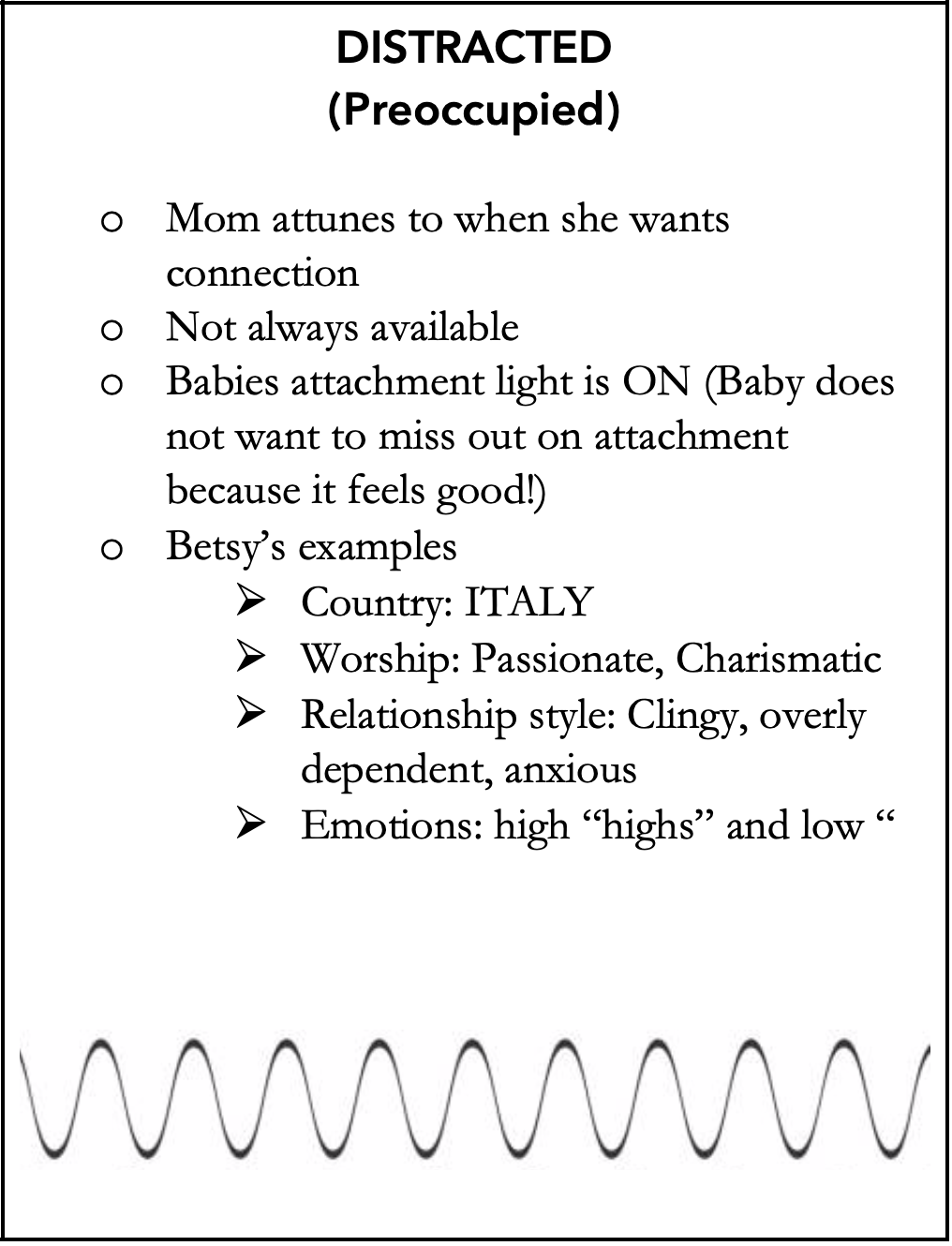Attachment 101
/By Betsy Stalcup, founder and executive director of Healing Center International
God made us to attach to him and to others. Isn’t that amazing? If we don’t learn how to attach to God, how to trust in his love, care and provision the world can be an anxious place. If we don’t learn to attach to safe families around us either biological or spiritual, we will find something to cling to. It could be sugar, or performance, or cocaine.
Our attachment style forms during our first 1000 days [1] of life, from the moment of conception to our second birthday. During those same 1000 days, our brain grows. In the womb we grow our brain stem and the lower levels of our right hemisphere. Once we are born, our brain continues to grow, in spurts, in response to our interactions with our mother or primary attachment figure (PAF).
Babies are born with no ability to regular their emotions, so they need to be seen with great compassion. Mom (or the PAF) bonds with Baby, and regulates the emotions of both herself and her baby—this includes positive and negative emotions. How does this happen? Primarily by face-to-face communication like we saw in last month’s blog post.
Today we are focused on attachment styles. Researchers have identified four attachment styles that form during the first two years of life and often predict how we will behave in close relationships for the rest of our lives.
For the baby to have secure attachment, his/her mother needs to attune to them regularly. Allan Schore, MD, describes this attunement as “good enough” because no mother is able to attune to her baby all the time. About 50% is deemed good enough.
For a secure attachment to form, Mom needs to respond to her baby quickly. When Baby wants to attach, when Baby’s attachment light is on (by this we mean that the attachment center of Baby’s brain is active), Mom’s attachment light comes on and the two communicate back and forth with each other, just like we saw in last month’s blog post. Those interactions build healthy rhythms of joy and rest. Mom is sensitive to Baby’s capacity and senses when Baby needs a rest. Babies will look up and right when needing a break.
As an example of secure attachment, I chose the country of Denmark, often dubbed “the happiest country in the world.” It is also a land where new moms can have a full year of maternity leave (unlike the U.S. which is one of only four countries in the world that have no maternity leave). What kinds of churches exemplify a secure attachment? Churches that use both the right and left hemispheres of the brain. Churches that draw people to God through reason and words, as well as emotions and beauty. In these churches people are drawn to God by love, not fear. Securely attached people have a secure relationship style and are confident and hopeful. They are not anxious about relationships and do not avoid intimacy. People who are securely attached experience a healthy range of both negative and positive emotions and live in a cycle of joy and shalom as illustrated by the lovely curving line.
When there is little or no social interaction from Mom (recall the video from last month), Baby develops a dismissive (also called avoidant) attachment style. Mom is not sensitive to Baby’s emotional or social cues, so Baby’s attachment light turns off. In Baby’s experience, relationships are not a source of joy. Better to go it alone and find something else to attach to such as work, performance, shopping, eating, drugs or alcohol.
My example of a country would be England, home of the stiff upper lip. Also, the land where the upper class historically sends their children off to elite boarding schools. Dismissive adults tend to undervalue relationships and emotions, and will therefore tend to choose churches that focus on reason and logic; on principles rather than relationships. Both high and low emotions are suppressed as is illustrated by the curvy line in the dismissive attachment box. The line has low amplitude—a limited range of emotion. Our American culture which looks up to independent people who don’t need anyone, often sees those with dismissive attachment styles as being strong, but in reality, they long for intimacy but do not know how to get what they need.
Sometimes Mom attunes or pays attention to the child when she is in the mood for interaction but otherwise ignores her baby’s social needs. Baby quickly realizes that connecting with Mom feels great! So, she vigilantly watches mom to make sure she does not miss out on the good stuff when mom is wanting to interact. As a result, Baby’s attachment light is always on and she develops a distracted attachment style.
My example of a country would be Italy, land of passion where even talking is emphatic, pronouncing every syllable: Bru-sche-tta! Piz-zah! A distracted worship style might be passionate, and charismatic. Reason and logic would not be deemed as important as a love relationship with God, but that relationship might be stormy for a person with distracted attachment who might feel that no relationship is ever enough. The relationship style of someone with a distracted attachment style might be clingy, overly dependent or anxious. As we can see from our sine curve people with distracted attachment tend to experience both higher and lower emotions than those with a secure attachment. Our culture often mocks people with distracted attachment seeing them as drama kings or queens.
The most difficult attachment style is the disorganized style. In this case Mom or the caregiver misattunes to Baby. They do not reliably meet his needs. Mom is both a source of joy and terror. She may be a drug addict who does not provide reliable care when she is high. Or she might be mentally ill, have unprocessed trauma, or have disorganized attachment herself. In this case Baby’s attachment light comes on erratically. The caregiver gives confusing signals that Baby cannot interpret reliably—come here, go away. Adults who developed disorganized attachment as infants and toddlers often feel dazed, confused, or hostile. They may have a need to control their lives or even others. They may see themselves as victims. They may not have much capacity to deal with the everyday ups and downs of life. 80% of abused children have disorganized attachment. Disorganized attachment is the least common attachment style in most of the U.S. but it is common in the inner city.
My example of a country is Russia where “drinking is a pervasive, socially acceptable behavior. . . .” [2]Churches that preach “fire and brimstone” or portray God as angry and punishing tend to draw people with disorganized attachment. Relationships for those who have disorganized attachment tend to be stormy, turbulent and bonded by fear, not love. The line depicting the emotional highs and lows of a person with disorganized attachment show the unpredictable swings of a person in great pain.
What are we to make of these four attachment styles? Rest assured your attachment style is probably not as bad as you think. Most of us are on a continuum between a secure style and an insecure style. If you want to know where you fall, you can take an online test. We can also have different attachment styles with different people, or in different situations. I grew up in a home that was mostly secure but my father had extreme mood swings and so I experienced some aspects of disorganized attachment. The intensity of my husband’s recent illness caused some of those wounded parts to surface.
How can we help those with insecure attachments? Many seem to think that there is no help but I have found that spending time in the presence of God can bring great healing. As we form a secure attachment to God by simply being with him, bringing him all our joys and sorrows, we can begin to heal. Just as we needed lots of time with our mom or primary caregiver, we need lots of time with Jesus. As we are with him we see how loving he is, how glad he is to be with us and how attentive he is to our needs. His presence is healing.
How about you? Are you able to experience the presence of God?
I dream of a community where there are enough leaders trained in the Immanuel Approach that everyone can receive all they need to be able to connect with Jesus daily, to know his voice and feel his love. It can change the world.
Will you join me?
P.S. We would love to hear your ideas about characters in popular literature that exemplify these different attachment styles. Please respond in the comments section below.
[1] Pregnancy lasts 40 week or 280 day, two years of life 364 x 2 for a total of 1008 days.
[2] Wikipedia, https://en.wikipedia.org/wiki/Alcohol_consumption_in_Russiaaccessed May 2, 2019.






